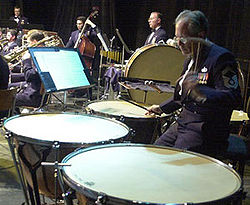
Back Keteltrom Afrikaans دفية (آلة موسيقية) Arabic Літаўры Byelorussian Тимпан Bulgarian Timpan BS Timbales Catalan Tympány Czech Timpani Welsh Pauke Danish Pauke German
 A timpanist | |
| Percussion instrument | |
|---|---|
| Other names | Kettledrums, Timps, Pauken |
| Hornbostel–Sachs classification | 211.11-922 (Struck membranophone with membrane lapped on by a rim) |
| Developed | at least c. 6th century AD |
| Playing range | |
Ranges of individual sizes[1]  | |
| Related instruments | |
| Sound sample | |
|
| |
Timpani (/ˈtɪmpəni/;[2] Italian pronunciation: [ˈtimpani]) or kettledrums (also informally called timps)[2] are musical instruments in the percussion family. A type of drum categorised as a hemispherical drum, they consist of a membrane called a head stretched over a large bowl traditionally made of copper. Thus timpani are an example of kettledrums, also known as vessel drums and semispherical drums, whose body is similar to a section of a sphere whose cut conforms the head. Most modern timpani are pedal timpani and can be tuned quickly and accurately to specific pitches by skilled players through the use of a movable foot-pedal. They are played by striking the head with a specialized beater called a timpani stick or timpani mallet. Timpani evolved from military drums to become a staple of the classical orchestra by the last third of the 18th century. Today, they are used in many types of ensembles, including concert bands, marching bands, orchestras, and even in some rock bands.
Timpani is an Italian plural, the singular of which is timpano. However, in English the term timpano is only widely in use by practitioners: several are more typically referred to collectively as kettledrums, timpani, temple drums, or timps. They are also often incorrectly termed timpanis. A musician who plays timpani is a timpanist.
